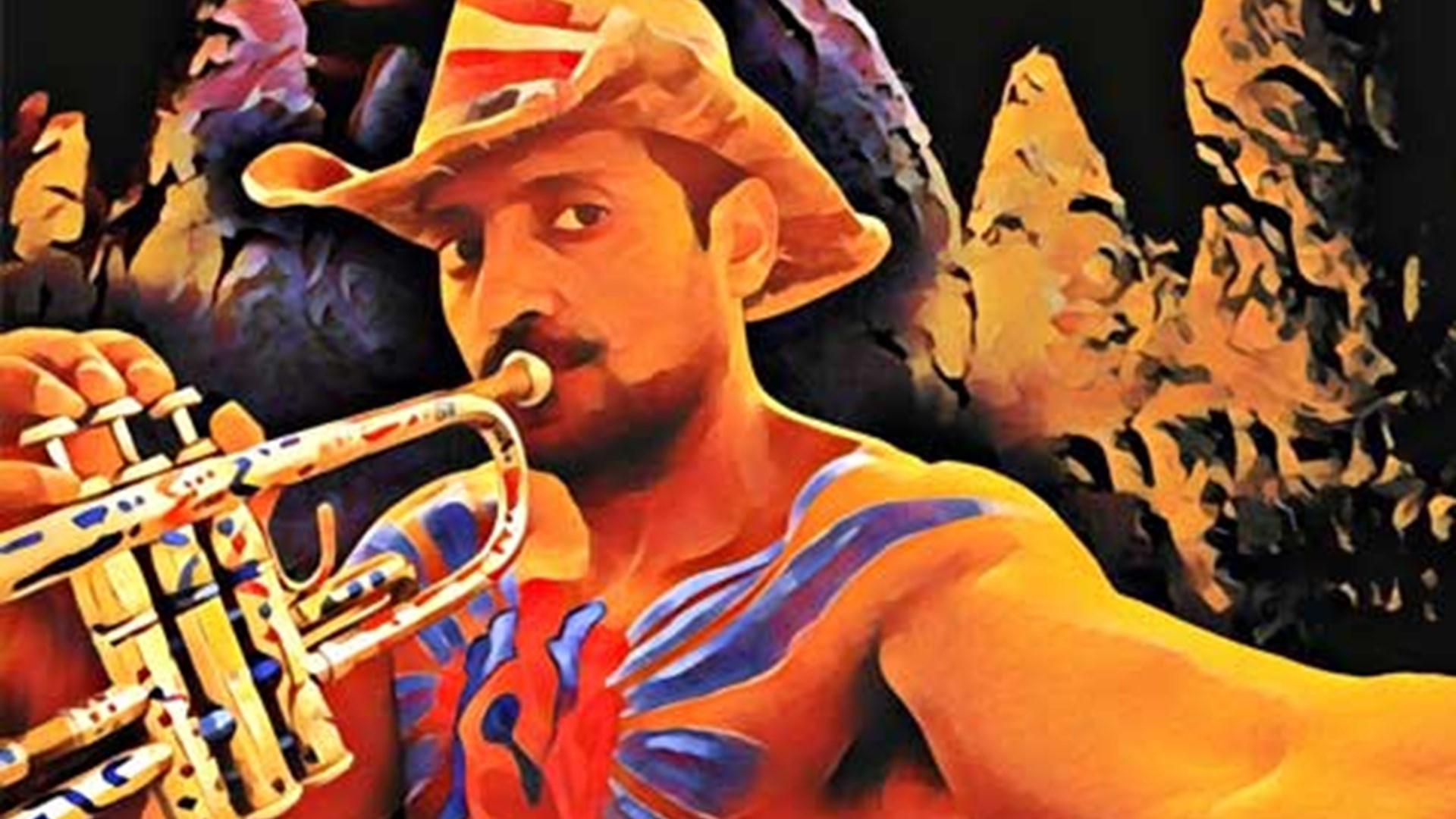The Wolf Diaries
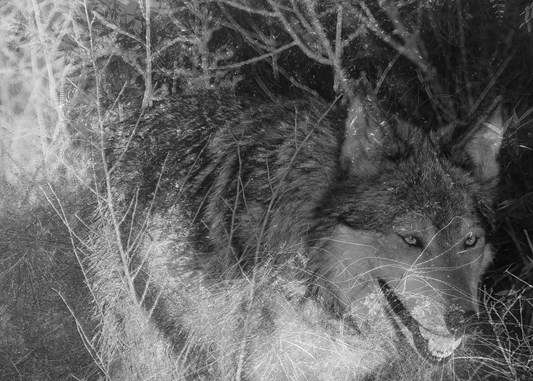
[Wolf Photo Credit: Larry Lamsa, “Mexican Wolf,” 2014 via Flickr; layered over a cell phone photo taken by the author]
Last night I dreamt of a rain-soaked wolf. It stood at the top of a winding stone staircase, pacing back and forth, its ash-colored body smoldering like a flame. I hesitated at the bottom of the steps, teetering between following the sounds of the wolf’s breathing or running away without looking back. The wolf crooned down to me, its voice encircling my body like a syrupy embrace. “Blue moon, you saw me standing alone, without a dream in my heart.” Its cries were a promise, what could be if I surrendered.A romance between lunar and fur, a return to an unnameable space. Our kiss drawing blood. “What big arms you have!”And from that blood an insatiability will be born. The better to smother me with. Frozen at the bottom, I tasted a metallic slipperiness. It stained my tongue. I swallowed the stain down. “You knew just what I was there for.”
Maybe the wolf came because I’ve been rereading Cristina Rivera Garza’s The Taiga Syndrome, translated from the Spanish by Suzanne Jill Levine and Aviva Kanan. Described as a “fairy tale run amok,” the book involves a missing couple, telegram crumbs, a wolf cub, a feral child, and a forest. When I first read the book two years ago, I was drawn to the repetition of the rectangle and the sacredness of its shape. Now, though, I find myself distracted by the wolf. Their fangs. Their pinching smell of wet fur. The primordial grammar held in their eyes. As I read and re-read, my focus strayed from what was right in front of me, a character leaping out the window into the cold arm of unknowing, to what remained in the shadows, the sulking wolf outside the frame. An intruder. Bringing to our door the mess of the forest.
The wolf and its habitat are presented as our negation. Or so we’re taught. Fairy tales and fables and folktales used the wolf as a warning bell, a nefarious villain to avoid or defeat. Think of the Big Bad incarnations blowing down houses and eating grandmothers. Creeping in the forests, disguising their ravenous appetite under sheep’s skin. In actuality, the wolf absorbed our delirious anxieties, the perfect vessel for our existential crises. All my knowledge of the wolf stems from this. I’ve never seen one up close. Outside of sanctuaries, it’s extremely rare to encounter one in Los Angeles. I know nothing about the animal as it exists in the now. Perhaps that is my first error: choosing mirages over presences.
I start collecting wolf sightings and remembrances. I tell myself these detours will reveal the meaning of the wolf in my dreams. There is a rush of blood to the head when setting out on an unmappable path. Especially if to do so is a disobedience. As I lap around my hilly neighborhood, passing Mediterranean Revival houses and hidden staircases, I imagine following a stray path that will lead me into the grasp of the forest. I act out other scenes in my mind, like turning a sharp corner and finding myself face to snout with the wolf, its eyes an inviting black void.
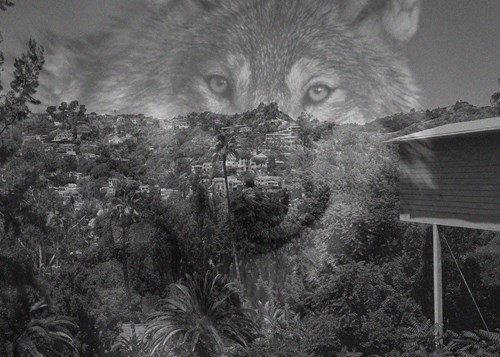
[Wolf Photo Credit: Public domain, 2018 via Flickr; layered over a cell phone photo taken by the author]
My first sighting was Tex Avery’s Wolfie, in the 1943 cartoon short, Red Hot Riding Hood. Tophat and tails, bulging eyes, sharp angels to cut yourself on, a swinger’s suggestive sneer. 100-pound tongue. Tex’s Wolfie isn’t afraid to howl his hardness. (In the 1945 follow-up short, Swing Shift Cinderella, Red, the lids of her exaggerated bedroom eyes painted baby blue, coos, “Ooh—Wolfie, ain’t you the one?”) He is a bullet of masculine lust. Grandma, brazen in a red halter dress, wants Wolfie all to herself. Her watering mouth drops the nastiest of hints. Her desire is played for laughs. Wolfie is ageist, so doesn’t indulge, is repulsed, really. He hungers after the promises of icy hot youth.
I imagine another existence, a version where the wolf and grandmother are lovers. Snout to lips, tongue massaging layers of unsaid dreams. Hold his paw and sing. In my story, Grandma would teach Wolfie how to listen to the textures of her sighs. She’d dress him up in velvet lingerie and silk ropes. Squeal while massaging his canine tooth with her middle finger and thumb. Wolfie would teach Grandma how to peel back layers of matted fur.Whispering the lyrics to her favorite song, “The only one my arms will ever hold.”
Or have I been hoodwinked by Wolfie, the unrepentant predator?
In “The Company of Wolves” by Angela Carter, the narrator warns of the animal’s carnivorousness, its devouring and disruptive force. When confronted by a wolf disguised as a hunter, Carter’s heroine makes a game of her desire. If he reaches grandma’s cottage first, he will get a kiss. She lets the wolf win. The wolf eats the grandmother, who is fooled by his impersonation of the granddaughter. Soon after her arrival, a tuft of grandmother’s hair alerts the heroine to the spectre of death. I’m fascinated by her decision to proceed despite her overwhelming fear. She listens to the moonlit wolfsongs before closing the window. Then she burns her red shawl in the fireplace. Then her blouse, skirt, stocking, shoes. She laughs when the wolf says his infamous lines. Undresses him instead, preparing for her own sumptuous meal.
There’s a wolf in the house. What I remember most from Ghostly Matters by Avery F. Gordon: Sabina Spielrein saw a wolf in the mirror. Terrified, she asked what it wanted. Her wolf-reflection intoned, “The great chill is coming.” After I read “distractions,” the chapter detailing the institutional erasure of Spielrein’s contributions to psychoanalysis, I placed the borrowed book in a corner of my studio apartment and didn’t return to it for many months. I was afraid to touch the pages, to collide again. Reading (and feeling) the words brought an impossible want. I felt hounded by the existence of a wolf-self and her adjacents. A black dog breathing slow in my dream. A coyote crossing the gaping boulevard during my morning commute. Their jangly sounds confusing the fresh dark of new day and my own scattering insomnia. The wolf cracking the mirror. Room gone crooked. Has the great chill arrived?
Perhaps that is why I desire (hungry like wolves)—to avoid the ravages of cold. Maybe it’s a curse. The wolf is haunted by a bottomless belly. A terrible wanting that won’t quit.
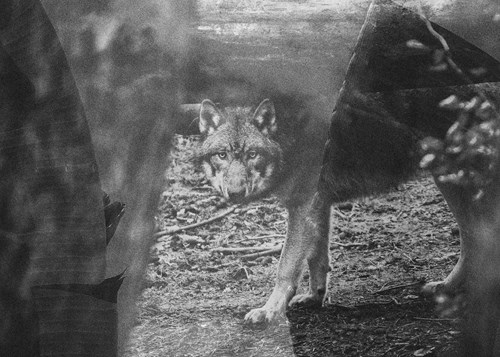
[Wolf Photo Credit: Ben Snaps, “The Wolf,” 2018 via Flickr; layered over a cell phone photo taken by the author]
I can’t talk about the wolf without mentioning the forest. The forest, the woods, their insides, are forbidden zones harboring chaos and latent fetishes, a location to avoid if you can, at least in fairy tales and other literature. The forest in Destroy, She Said by Marguerite Duras promises an apocalyptic invasion, one predicated on the annihilation of the self. Dante, lost and far from salvation’s straight path, wanders a selva oscura, or dark woods, which the Romans believed marked the entrance into Hades. Does our hostility bloom from the puzzle of a breathing forest? Its aliveness mocks our corralled sense of reality. Maybe that’s why the wolf is so fearsome. Touching it brings us closer to the inscrutable woods.
The Taiga Syndrome references L’Enfant Sauvage, the François Truffaut film based on the life of Victor of Aveyron, a child who spent the first twelve years of his life isolated in a French forest. He isn’t a wolf, but he behaves like one: walking on all fours, hairy, naked. His arc is familiar, the (forced?) passage from wildness to civility. A journey with many names—maturation, domestication, enlightenment. But these are also masks shielding the deeper narrative of othering and captivity. In order to pass as human, the feral child must give up their bones and instincts in exchange for reason and order. To be labeled as “uncivilized” signalled death, meant being exiled to a social purgatory.
Reverend Joseph Singh shot the she-wolf, his gesture of fatherly love. In a reversal, the Reverend blew down the wolf’s door. He had made it his mission to rehabilitate the sisters of Godamuri, Amala and Kamala, allegedly raised by the she-wolf and her pack. Before they were captured and removed from the jungle, the villagers referred to them as ghosts. Bhanu Kapil follows their traces in Humanimal: A Project For Future Children. Why is the wolfgirl an aberration? Because they disturb our violently constructed order. Reverend Singh noted their wolfish tendencies in his journal: affinity for raw meat, calloused palms and knees, aversion to sunlight, acute hearing, nocturnal. He wanted to remake them into his own vision of girlhood. Obedient, chaste, God-fearing. (Reverend Singh’s project was unsuccessful: Amala died of kidney failure in 1921, and Kamala died of tuberculosis in 1929.)
No sleep at all this week. I’m disturbed by the accounts of wolf children and their calloused skin. My own feet have been itchy and cracked lately, even after slathering them in coconut oil and shea butter. And my dreams have been empty, scooped out and replaced with gaps of nothingness. Always around three or four in the morning. It feels like the paws of someone jolting me awake. Except when I open my eyes, I see nothing but restless shadows and unfamiliar shapes. I don’t leave my bed, frightened by the thought of something lurking behind the corner. Ready to pounce, its body low to the tiled floor. What would you do if a wolf showed up at your door?
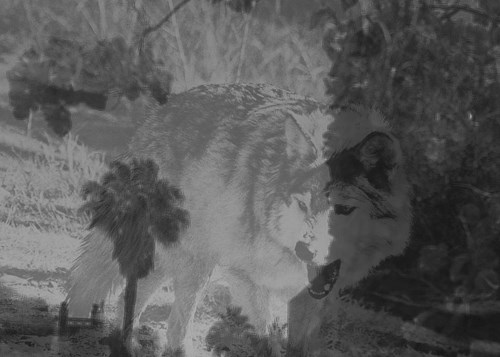
[Wolf Photo Credit: Larry Lamsa, “Mexican Wolf,” 2014 via Flickr; layered over a cell phone photo taken by the author]
Since that initial sighting at the top of the stairs, I’ve been waiting at my bedroom window, surveying the street below, lips painted burgundy and afro let loose, eager for another stolen glance, my mind tumbling with possibilities. Maybe I’ll glimpse tufts of ash fur in the lawn bordering my apartment building. Or spot its face in the reflection of the black round sunglasses worn by the hooded woman slinking by my window, her obedient bull terrier trotting a few steps ahead, while she stares up without shame, not letting go of my gaze until she reaches the window’s edge, then vanishing from view. In this fever play, I’ll suppress the urge to run outside, to yell down the street, to ask if she heard the growling coming from inside the shrubs.
Tallying my brief encounters with fictional wolves has fanned the flames. Looping around Bonair Place and Grace Avenue in a sun-baked daze, I superimpose what isn’t there over the cypress trees and asparagus ferns and foxtail agaves.
When the wolf comes back, I know it will suck me bone dry.
Thom Yorke sneers, “Don’t look in the mirror at the face you don’t recognize.” The wolf face? He keeps the wolf from the door. No matter. The wolf calls his phone. “Don’t you dare, don’t you dare.”I daydream about picking up the phone and purring: Do you remember your first taste of blood? I do. I was a tight fist clenching. The wolf advanced closer, slow. I was a tight fist pulsing. Had I never stepped this far? The wolf lashed out like a fang. Releasing, I screamed. My nails were talons. Suddenly, the thing I wanted to do most was lick blood off my talontips. The wolf called me an animal, said I smelled just like a murder, fresh.
*
Under last night’s Worm Moon, the full moon in Libra, I waited for you, disguising my longing with a song. Eyes shut and mind liquidating, I swayed, caught in a tornado of sound: saxophones, organs, bratty guitars, drums, bass. Blasting “Pile Ou Face” by Les Loups Noirs, a Haitian band popular in the ‘70s. Heads or tails. Gardner Lalanne’s staticy trills transmute speech into a playground of berserking pitch. His wails seeped into my bloodstream, a bubbling sensation accompanied by a euphoric throb. I was wayward, eyes glistening and mouth slack. Winding and squatting and popping and clapping. Towards the end of the song, Reginald Roc’s saxophone takes over, cutting a zigzagging path through the funky konpa beat. The sax noises could be you, leading me back into the arms of the screaming forest.
*
A wolf is a reminder. I am escaping, on all fours, slick with sweat, feasting on your howls, your eyes, your mouth. Tongue to tongue, enjambment, spitting back and forth a language we do not know.
I follow the bloody paw prints.
Artist Statement
There is a proverb in Haitian Kreyòl, “Paròl gin pié zèl”—“Words can give your feet wings.” This phrase guides my writing practice. I encountered it via Edwidge Danticat's Breath, Eyes, Memory. The phrase appears on the last page, during an emotional conversation between Sophie, the novel's narrator, and her grandmother. You can feel the energy rising from the text, daring you to see what has been hidden.
For me, writing is an electric charge. A path sideways and backwards and through. Writing always entails at least a you and I, a conversation, a commingling. And a loss. Language is imprecise; it cannot capture every beat of my heart. But our contact, our collaboration through reading, provides an opportunity to invent a new language, one that considers the silences and excesses, desires and possibilities.
Wolf Diaries blends nonfiction and fiction, using a real-life experience (working on an essay on The Taiga Syndrome by Cristina Rivera Garza) and twisting it into the realm of fantasy. In the novel, one narrative thread involves a wolf cub pursuing a couple on the run. I became fascinated with this wolf, which made me think of the other wolves I've encountered through books, cartoons and movies. The narrator is me and is not me—an unruly avatar that allows space to explore my shadow selves (as inspired by Martine Sym's Shame Space and the video work of Nina Menkes). The photos combine stock imagery of wolves with cell phone pictures of my neighborhood taken during my walks.

Biography
Allison Noelle Conner is a writer and editor. Her writing has appeared in Carla, Hyperallergic, and Triangle House Review and in the anthologies Forward: 21st Century Flash Fiction and Rockhaven: A History of Interiors. She has a newsletter about movies called Loose Pleasures. Born in Fort Lauderdale, Florida, Conner lives in Los Angeles.
Artist Q + A

Curated by Eva Recinos
Curator's Statement
"For this project, I wanted to ask artists to think about the natural motifs that are taking their attention during this unprecedented time—and how they might be influencing their creative process. How do we learn from the regenerative qualities of nature? What has the tree seen in all its years of living?"



